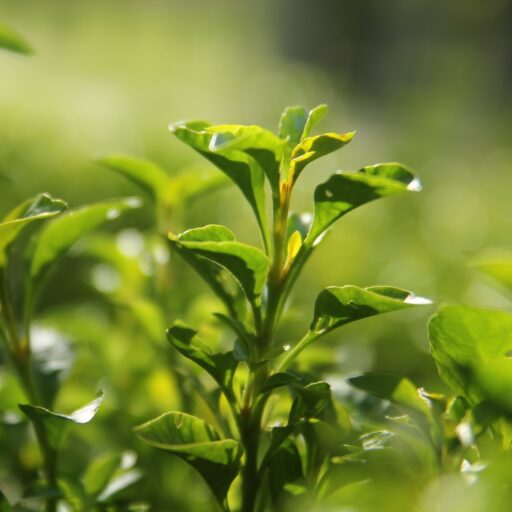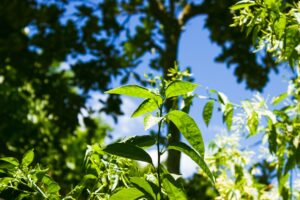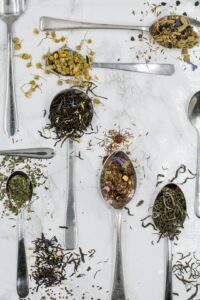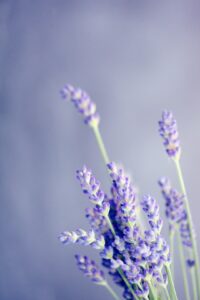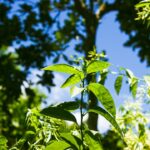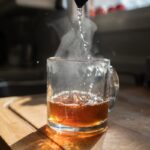Support our educational content for free when you purchase through links on our site. Learn more
[2023] List of Herbs for Tea: A Comprehensive Guide to Herbal Infusions
Are you tired of the same old tea flavors? Looking to explore new tastes and health benefits? Well, you're in luck! Our team at Growing Teas™ has put together a comprehensive guide to the list of herbs for tea. In this article, we'll introduce you to a variety of herbs that can be used to create delicious and soothing herbal infusions. So grab your favorite mug and let's dive in!
Table of Contents
- Quick Answer
- Quick Tips and Facts
- Benefits of Herbal Teas
- FAQ
- Tea Match Quiz
- Relax While You Read
- What to "Sip On" Next
- Nettle Tea Guide
- How to Make Horchata Tea
- A Hot Toddy For Tea-Time
- Cranberry Tea Punch, 2 Ways
- Chai-Spiced Pumpkin Pie
- Social Out-pour
- FAQ
- Conclusion
- Useful Links
- Reference Links
Quick Answer
Looking for a diverse range of herbal teas? Check out the list of herbs below that can be used to create flavorful and aromatic infusions. Explore brands like Twinings, Yogi Tea, and Traditional Medicinals for a wide variety of herbal tea options.
Quick Tips and Facts
Before we delve into the world of herbs for tea, here are some quick tips and interesting facts to get you started:
- Herbal teas are technically not "teas" in the traditional sense, as they do not come from the Camellia sinensis plant. Instead, they are infusions made from various herbs, flowers, fruits, and spices.
- Herbal teas are often referred to as tisanes.
- Different herbs offer different health benefits and flavors, allowing you to customize your tea experience.
- When brewing herbal teas, it's best to use freshly boiled water and steep the herbs for 5-10 minutes to extract their flavors and benefits.
- Feel free to experiment with different combinations of herbs to create your own unique blends.
Now that you have a basic understanding, let's explore the wonderful world of herbal teas!
Benefits of Herbal Teas
Herbal teas offer a wide range of health benefits, making them a popular choice for those seeking natural remedies. Here are some key benefits of incorporating herbal teas into your daily routine:
-
Promotes relaxation and sleep: Chamomile tea is renowned for its calming properties and is often used to promote relaxation and improve sleep quality.
-
Boosts immunity: Echinacea, elderberry, and ginger teas are known for their immune-boosting properties, helping to ward off common illnesses.
-
Aids digestion: Peppermint and ginger teas can help soothe digestive discomfort, reduce bloating, and relieve nausea.
-
Supports respiratory health: Thyme, eucalyptus, and licorice root teas are believed to have expectorant properties, helping to ease congestion and promote respiratory health.
-
Provides antioxidant protection: Many herbal teas, such as green tea, rooibos, and hibiscus, are rich in antioxidants that help fight free radicals and protect against oxidative stress.
-
Calms the mind and relieves stress: Lavender, lemon balm, and passionflower teas are known for their calming effects, helping to reduce stress and anxiety.
-
Promotes healthy skin: Nettle and dandelion root teas are believed to have detoxifying properties that can promote clear and healthy skin.
-
Supports women's health: Raspberry leaf and red clover teas are often used to support women's health, particularly during pregnancy and menopause.
It's important to note that while herbal teas offer numerous benefits, they should not replace medical advice or treatment. If you have any specific health concerns, it's always best to consult with a healthcare professional.
FAQ
What herbs can be used in tea?
When it comes to herbs for tea, the options are virtually endless. Here are some popular herbs that can be used to create delicious and aromatic infusions:
- Chamomile
- Peppermint
- Lemon balm
- Lavender
- Ginger
- Echinacea
- Hibiscus
- Rosemary
- Thyme
- Nettle
- Dandelion root
- Raspberry leaf
These herbs can be used individually or combined to create unique and flavorful blends. Feel free to experiment and find your favorite combinations!
What herbs are best to infuse in tea?
Certain herbs are particularly well-suited for infusing in tea due to their flavors and health benefits. Here are some popular choices:
- Chamomile: Known for its calming properties and delicate floral flavor.
- Peppermint: Refreshing and soothing, with a cooling minty taste.
- Lemon balm: Citrusy and refreshing, often used to promote relaxation.
- Lavender: Fragrant and floral, adds a touch of elegance to any tea blend.
- Ginger: Spicy and warming, great for digestion and adding depth to tea blends.
- Hibiscus: Tart and vibrant, often used in fruity herbal teas and iced teas.
These herbs can be enjoyed on their own or combined with other ingredients to create unique and flavorful infusions.
What are the 10 best teas?
Choosing the "best" teas can be subjective, as it depends on personal preferences. However, here are 10 popular teas that are loved by many:
- Green tea
- Chamomile tea
- Peppermint tea
- Earl Grey tea
- Rooibos tea
- Matcha tea
- Jasmine tea
- Ginger tea
- Hibiscus tea
- Lemon ginger tea
These teas offer a variety of flavors and health benefits, making them a great starting point for tea enthusiasts.
What herbs make tea taste good?
The taste of herbal tea can be enhanced by adding complementary herbs and ingredients. Here are some herbs that can make your tea taste even better:
- Mint: Adds a refreshing and cooling flavor to any tea blend.
- Lemon verbena: Imparts a bright and citrusy taste to teas.
- Cinnamon: Adds warmth and a hint of spice to tea blends.
- Stevia: A natural sweetener that can be used to enhance the sweetness of herbal teas.
These herbs can be used in moderation to add depth and complexity to your tea creations.
Tea Match Quiz
Not sure which herbal tea to try next? Take our Tea Match Quiz to discover the perfect herbal infusion for your taste preferences and health goals. Whether you're looking for a soothing bedtime blend or an invigorating morning pick-me-up, our quiz will help you find the ideal tea for any occasion.
Relax While You Read
Before we move on to more herbal tea goodness, take a moment to relax and enjoy a cup of your favorite brew. Sit back, unwind, and let the soothing aromas and flavors transport you to a place of tranquility. Remember, tea is not just a beverage—it's a mindful experience.
What to "Sip On" Next
Now that you're feeling rejuvenated, let's explore some specific herbal teas and recipes that are sure to delight your taste buds. From classic favorites to unique concoctions, there's something for everyone to enjoy. So grab your teapot and get ready to sip on these delightful creations:
- Nettle Tea Guide
- How to Make Horchata Tea
- A Hot Toddy For Tea-Time
- Cranberry Tea Punch, 2 Ways
- Chai-Spiced Pumpkin Pie
Each section will provide detailed instructions, tips, and interesting facts to enhance your tea experience. So, let's dive in and discover some exciting new flavors!
Nettle Tea Guide
Nettle tea, made from the leaves of the stinging nettle plant, is a popular herbal infusion known for its health benefits. Rich in vitamins, minerals, and antioxidants, nettle tea offers a range of potential advantages, including:
- Anti-inflammatory properties: Nettle tea may help reduce inflammation in the body, making it beneficial for conditions like arthritis.
- Allergy relief: Some studies suggest that nettle tea may help alleviate symptoms of seasonal allergies, such as sneezing and itching.
- Urinary tract health: Nettle tea has diuretic properties and may support urinary tract health.
- Hair and skin health: Nettle tea is often used topically to promote healthy hair and skin.
To make nettle tea, follow these simple steps:
- Boil water and pour it over dried nettle leaves in a teapot or mug.
- Steep for 5-10 minutes.
- Strain the leaves and enjoy your nettle tea plain or with a touch of honey or lemon.
Nettle tea can also be combined with other herbs, such as mint or chamomile, to create unique flavor profiles. So go ahead and give nettle tea a try—it might just become your new favorite!
How to Make Horchata Tea
Horchata tea is a delicious and refreshing drink that originated in Latin America. It is typically made from rice, cinnamon, and other flavorful ingredients. Here's a simple recipe to make your own horchata tea:
Ingredients:
- 1 cup long-grain white rice
- 4 cups water
- 1 cinnamon stick
- 1/2 cup milk (or non-dairy alternative)
- Sweetener of your choice (such as sugar or honey)
- Ice cubes
Instructions:
- Rinse the rice under cold water until the water runs clear.
- In a blender, combine the rinsed rice, water, and cinnamon stick. Blend until the mixture is smooth and well-combined.
- Pour the mixture into a pitcher and let it sit in the refrigerator for at least 4 hours or overnight.
- Strain the mixture through a fine-mesh sieve or cheesecloth to remove any solids.
- Add milk and sweetener to taste. Stir well.
- Serve the horchata tea over ice cubes and enjoy!
Horchata tea is a delightful alternative to traditional herbal teas and is perfect for hot summer days or as a sweet treat any time of the year.
A Hot Toddy For Tea-Time
If you're in the mood for a warm and comforting beverage, a hot toddy is the perfect choice. Traditionally made with whiskey, honey, lemon, and hot water, this classic drink can be given a tea twist. Here's how to make a hot toddy with tea:
Ingredients:
- 1 tea bag (black tea or herbal tea of your choice)
- 1 tablespoon honey
- 1 ounce whiskey (optional)
- 1 slice of lemon
- Hot water
Instructions:
- Place the tea bag in a mug and pour hot water over it.
- Let the tea steep for the recommended time.
- Remove the tea bag and stir in the honey until it dissolves.
- Add the whiskey, if desired, and squeeze the lemon slice into the mug.
- Stir well and enjoy your hot toddy tea!
This cozy beverage is perfect for chilly evenings or when you need a little pick-me-up. So grab your favorite tea and get ready to warm up from the inside out!
Cranberry Tea Punch, 2 Ways
If you're hosting a gathering or simply want to enjoy a refreshing drink, cranberry tea punch is a crowd-pleaser. Here are two delightful variations to try:
Classic Cranberry Tea Punch:
Ingredients:
- 4 cups cranberry juice
- 2 cups brewed black tea
- 1 cup orange juice
- 1/2 cup lemon juice
- 1/4 cup honey or maple syrup
- Fresh cranberries and orange slices for garnish
- Ice cubes
Instructions:
- In a large pitcher, combine the cranberry juice, brewed black tea, orange juice, lemon juice, and honey or maple syrup. Stir well to combine.
- Add ice cubes to the pitcher or individual glasses.
- Garnish with fresh cranberries and orange slices.
- Serve and enjoy!
Sparkling Cranberry Tea Punch:
Ingredients:
- 2 cups cranberry juice
- 1 cup brewed black tea
- 1 cup sparkling water or club soda
- 1/4 cup lemon juice
- 1/4 cup honey or maple syrup
- Fresh cranberries and mint leaves for garnish
- Ice cubes
Instructions:
- In a large pitcher, combine the cranberry juice, brewed black tea, sparkling water or club soda, lemon juice, and honey or maple syrup. Stir well to combine.
- Add ice cubes to the pitcher or individual glasses.
- Garnish with fresh cranberries and mint leaves.
- Serve and enjoy!
These cranberry tea punches are perfect for any occasion and are sure to impress your guests with their vibrant colors and refreshing flavors.
Chai-Spiced Pumpkin Pie
What's better than a slice of pumpkin pie? A chai-spiced pumpkin pie, of course! This delightful twist on a classic dessert combines the warm flavors of chai tea with the creamy goodness of pumpkin. Here's a recipe to satisfy your sweet tooth:
Ingredients:
- 1 pie crust (store-bought or homemade)
- 1 can (15 ounces) pumpkin puree
- 3/4 cup brown sugar
- 2 eggs
- 1/2 cup heavy cream
- 1/2 cup brewed chai tea, cooled
- 1 teaspoon ground cinnamon
- 1/2 teaspoon ground ginger
- 1/4 teaspoon ground cloves
- 1/4 teaspoon ground nutmeg
- Whipped cream and cinnamon for garnish
Instructions:
- Preheat your oven to 425°F (220°C).
- In a large bowl, whisk together the pumpkin puree, brown sugar, eggs, heavy cream, brewed chai tea, cinnamon, ginger, cloves, and nutmeg until well-combined.
- Pour the mixture into the pie crust and smooth the top with a spatula.
- Bake for 15 minutes, then reduce the oven temperature to 350°F (175°C) and continue baking for another 40-50 minutes, or until the center of the pie is set.
- Remove the pie from the oven and let it cool completely before serving.
- Garnish with whipped cream and a sprinkle of cinnamon.
This chai-spiced pumpkin pie is the perfect dessert for autumn gatherings or anytime you're craving a slice of something sweet and comforting.
Social Out-pour
We hope you've enjoyed this journey through the world of herbal teas and the delightful recipes we've shared. Don't forget to share your tea adventures with us on social media using the hashtag #GrowingTeas. We love hearing from fellow tea enthusiasts and discovering new tea inspirations!
FAQ
What are the health benefits of herbal teas?
Herbal teas offer a range of health benefits, from promoting relaxation and sleep to boosting immunity and aiding digestion. Each herb has its own unique properties, so it's worth exploring different varieties to find the ones that suit your needs.
Can I drink herbal tea every day?
Yes, you can drink herbal tea every day, as long as you're mindful of any potential interactions with medications or existing health conditions. It's always a good idea to consult with a healthcare professional if you have any concerns.
Are there any side effects of herbal teas?
While herbal teas are generally safe to consume, some individuals may experience allergic reactions or interactions with certain medications. It's important to be aware of any potential side effects and consult with a healthcare professional if needed.
Can I mix different herbs together to create my own tea blend?
Absolutely! Mixing different herbs together is a great way to create your own unique tea blends. Just remember to experiment with different combinations and ratios to find the flavors and benefits you enjoy.
Conclusion
We hope this comprehensive guide to the list of herbs for tea has inspired you to explore new flavors and reap the benefits of herbal infusions. Whether you're sipping on a soothing chamomile tea or indulging in a chai-spiced pumpkin pie, herbal teas offer endless possibilities for both taste and well-being. So go ahead, get creative, and enjoy the world of herbal teas!
Useful Links
- Shop Twinings on Amazon
- Shop Yogi Tea on Amazon
- Shop Traditional Medicinals on Amazon
- Shop herbal teas on Amazon
- Shop books on herbal teas on Amazon
- Discover more tea resources on the Growing Teas™ website
